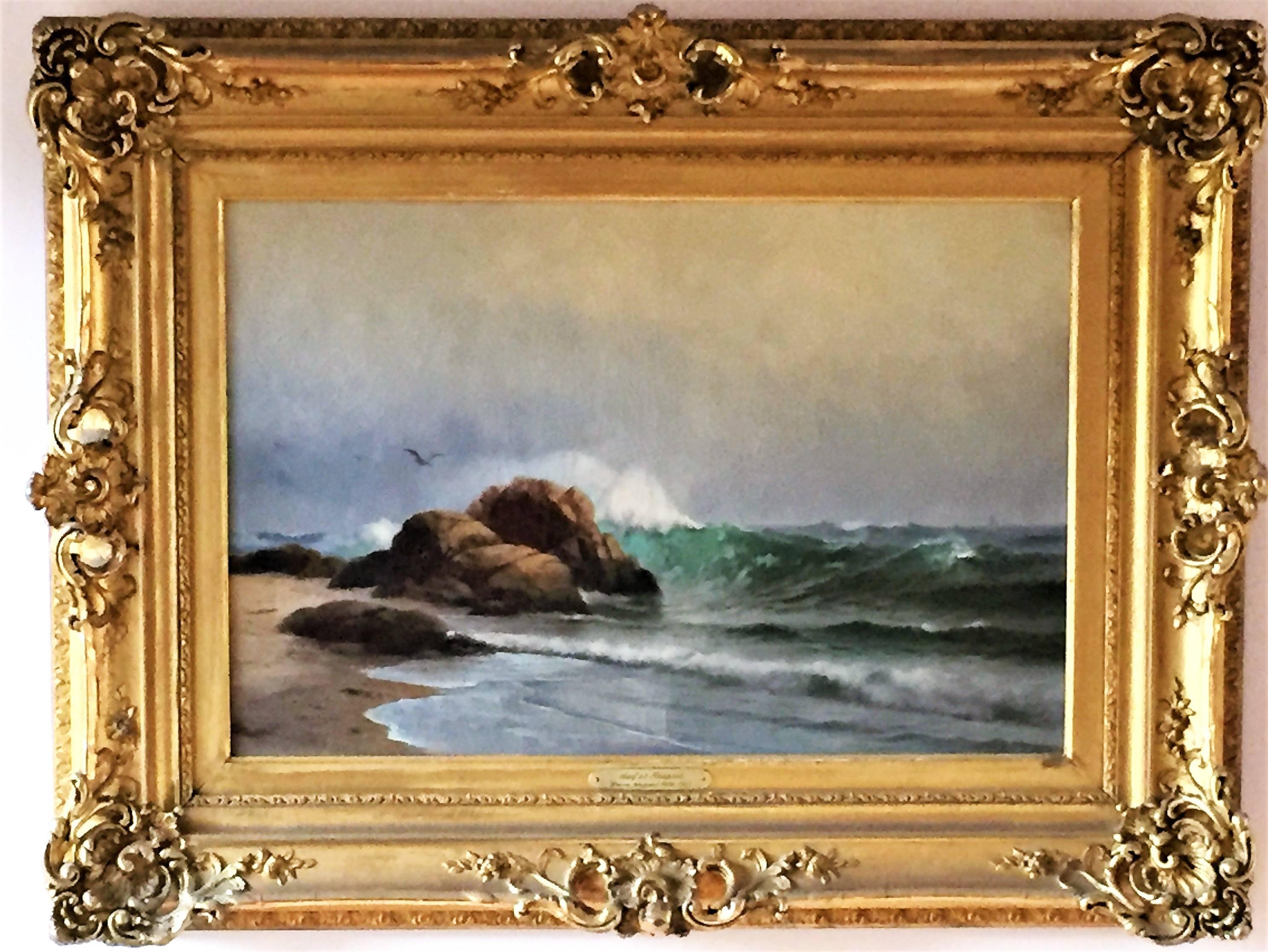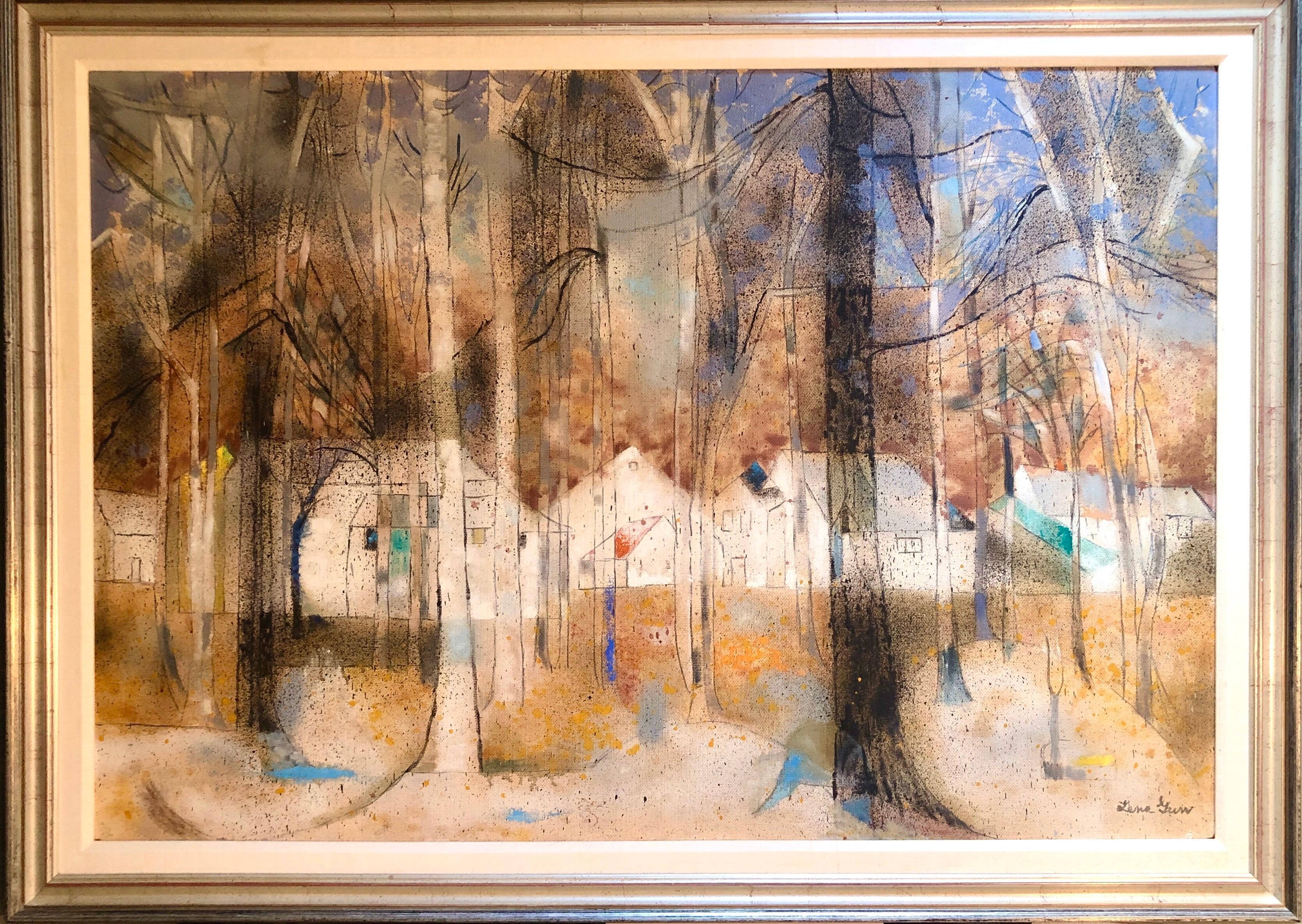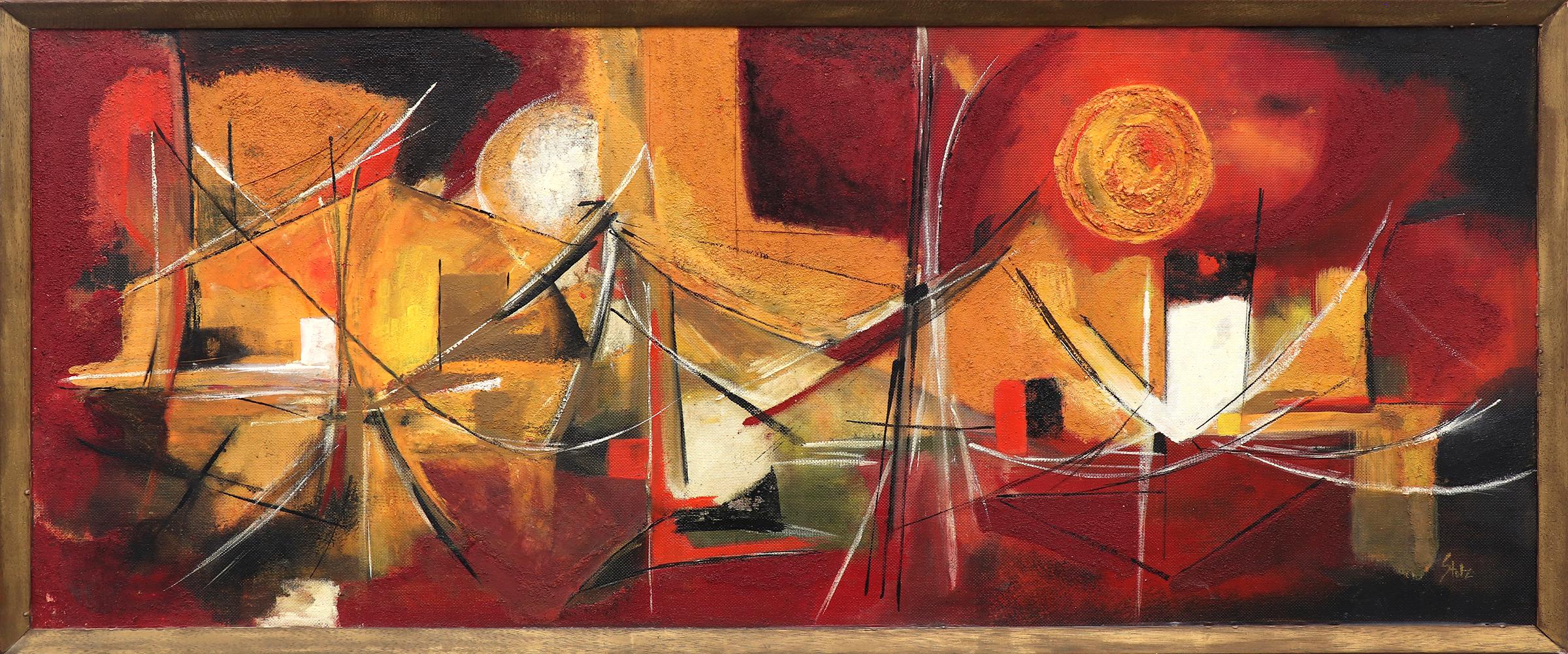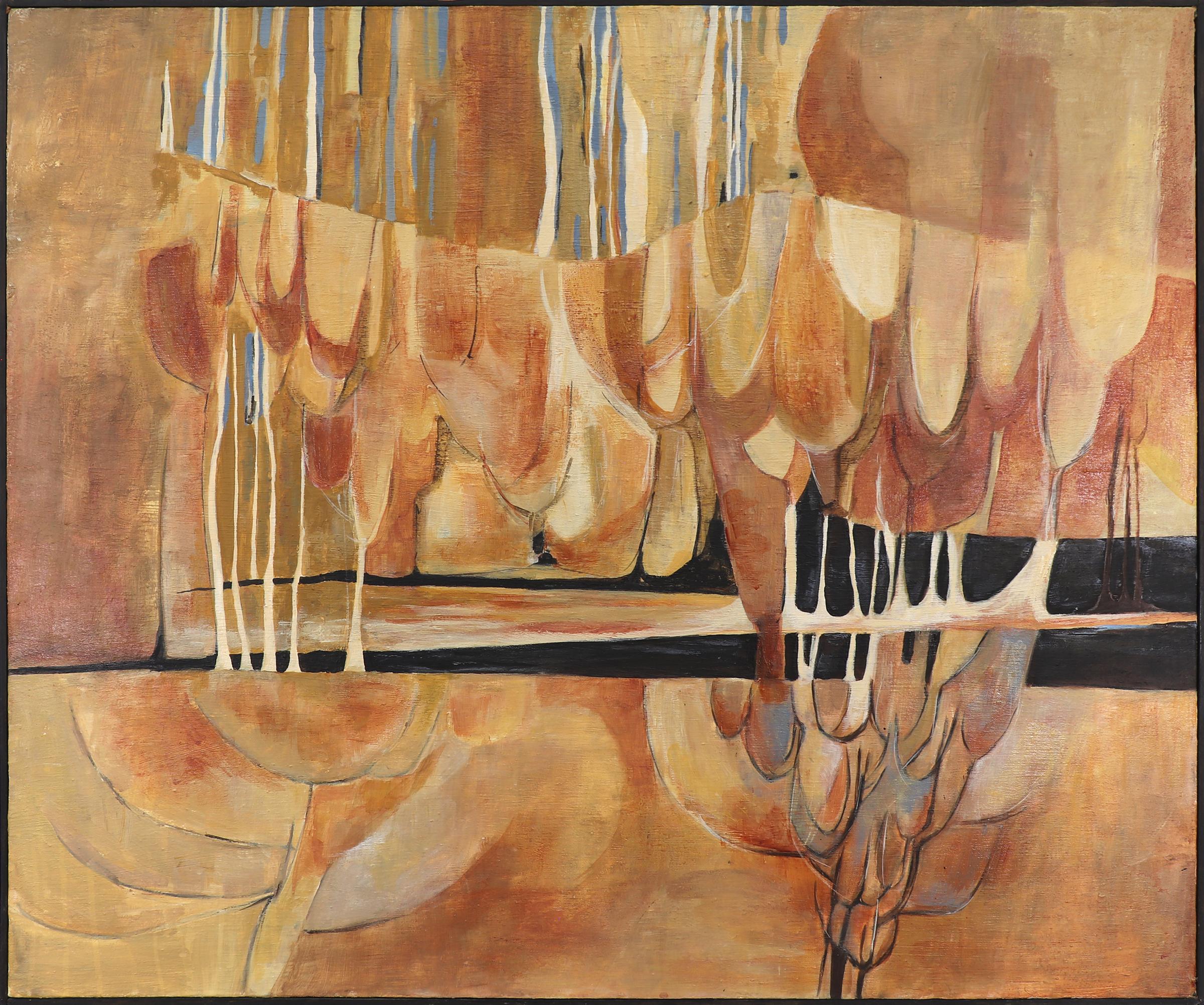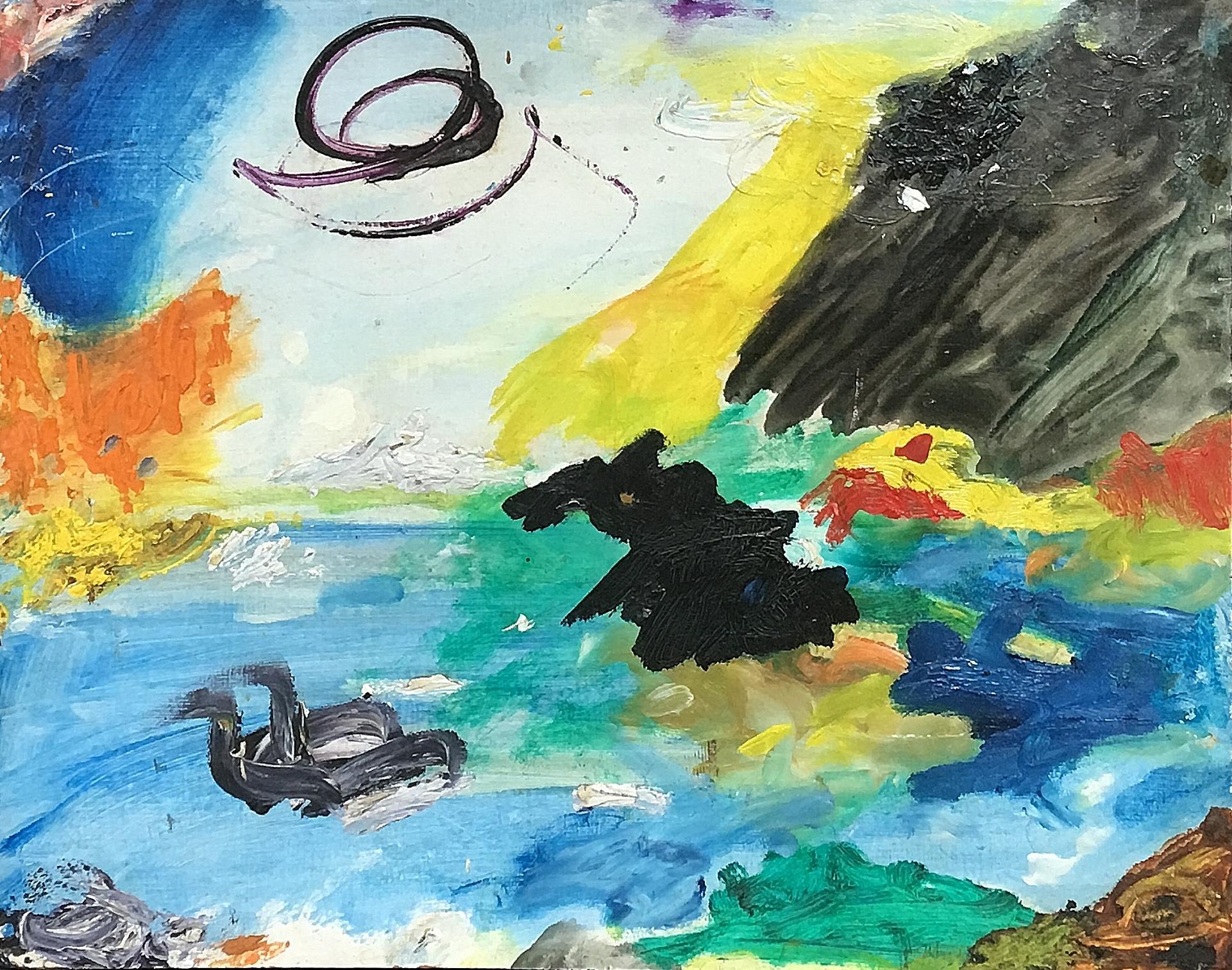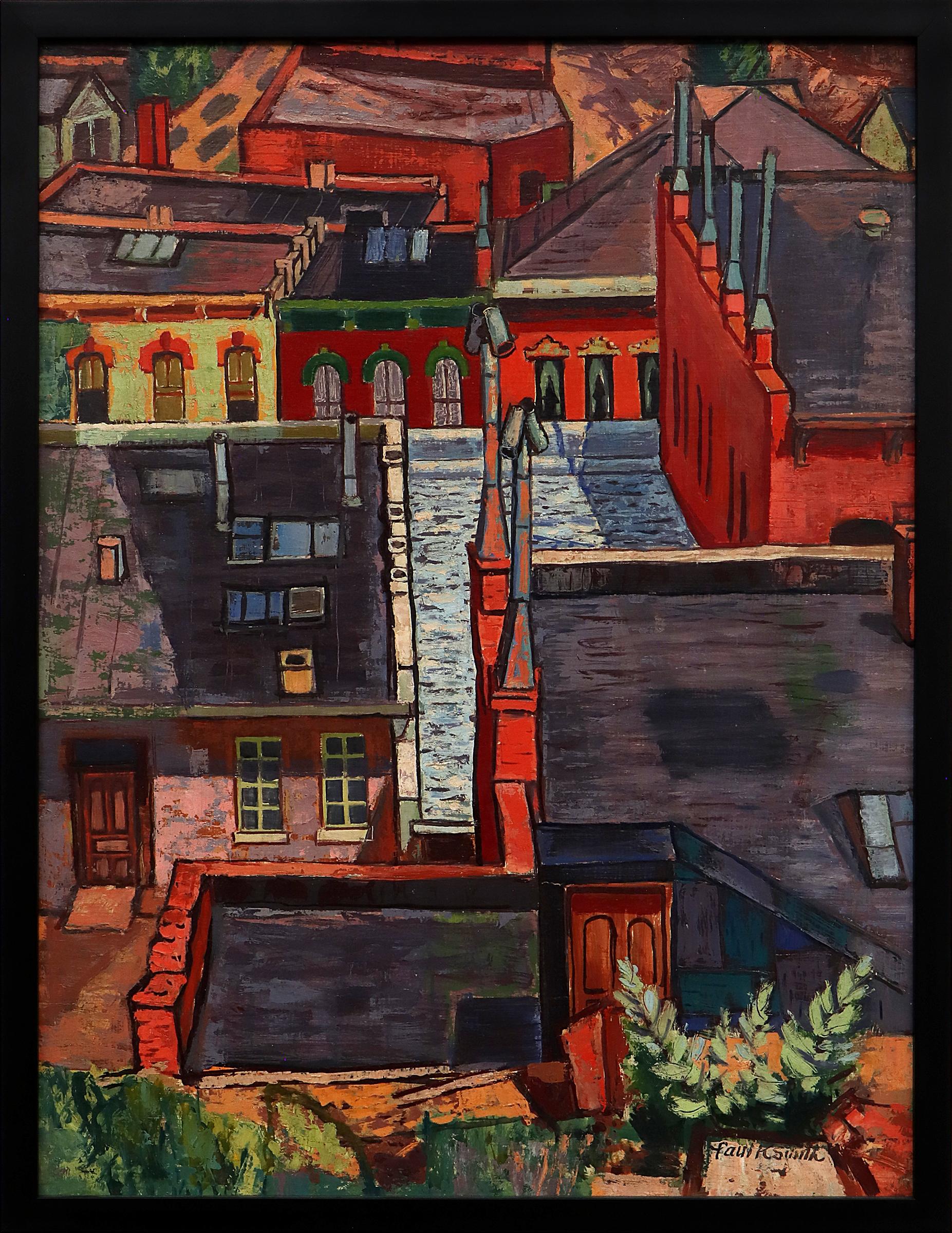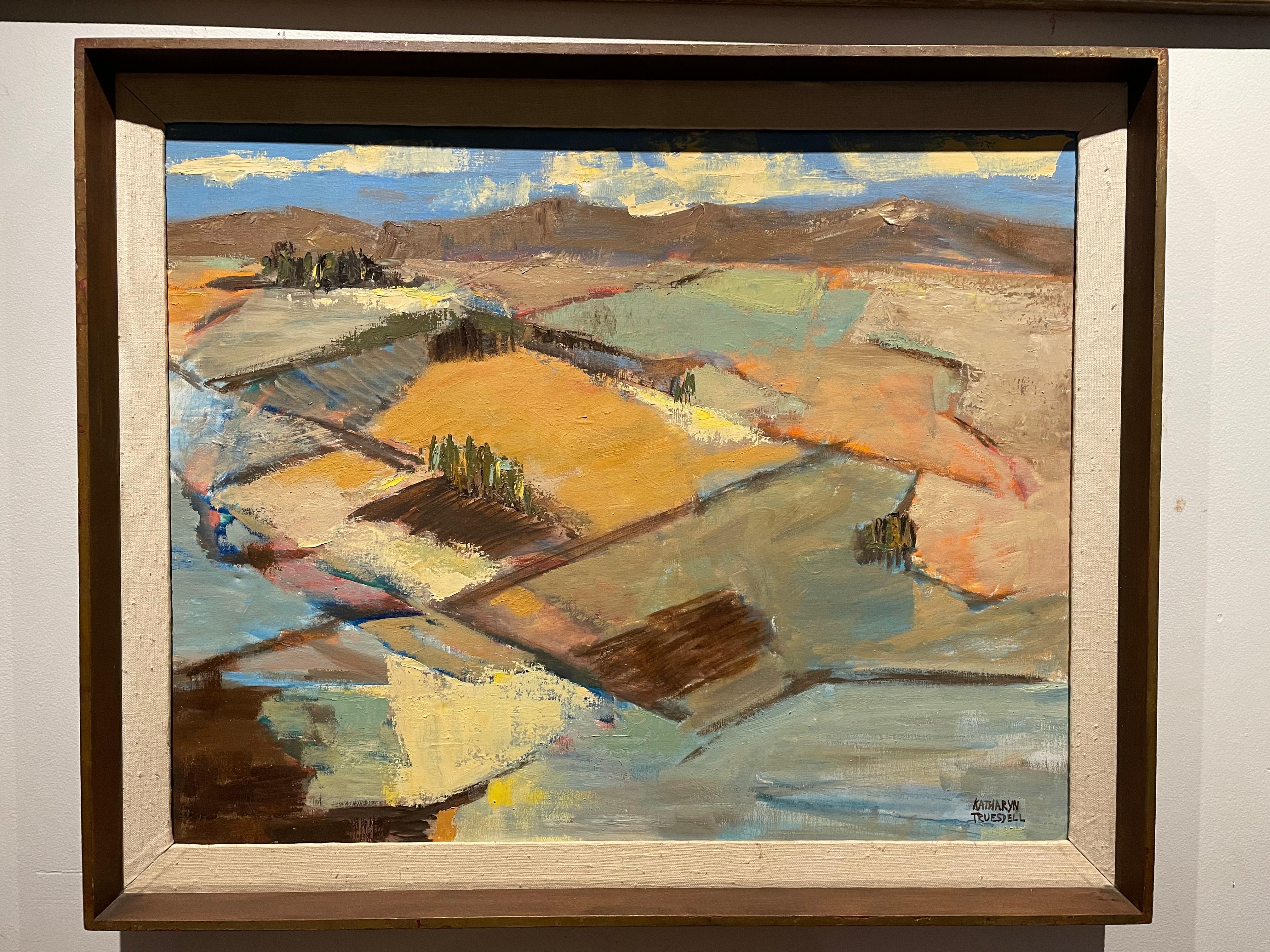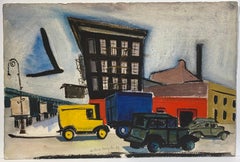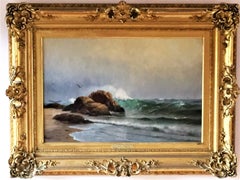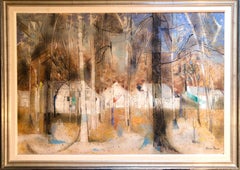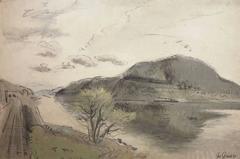
Silver Landscape (Grey abstract grisaille landscape)
View Similar Items
Want more images or videos?
Request additional images or videos from the seller
1 of 9
Joe JonesSilver Landscape (Grey abstract grisaille landscape)1947
1947
About the Item
- Creator:Joe Jones (1909 - 1963, American)
- Creation Year:1947
- Dimensions:Height: 33 in (83.82 cm)Width: 45 in (114.3 cm)Depth: 3 in (7.62 cm)
- Medium:
- Movement & Style:
- Period:
- Condition:
- Gallery Location:Wilton Manors, FL
- Reference Number:1stDibs: LU24521431273
About the Seller
4.9
Gold Seller
These expertly vetted sellers are highly rated and consistently exceed customer expectations.
Established in 2007
1stDibs seller since 2015
328 sales on 1stDibs
Typical response time: 9 hours
More From This SellerView All
- Christopher Street (abstract Greenwich Village cityscape)By De Hirsch MargulesLocated in Wilton Manors, FLDe Hirsh Margules (1899-1965). Christopher Street, 1939. Watercolor on Arches wove paper. Signed and dated in pencil by artist lower margin. Sheet measures 15.5 x 20 inches. Window in matting measures 15 x 19 inches. Framed measurement: 23 x 30 inched. Bears fragment of original label affixed on verso. Incredibly vibrant and saturated color with no fading or toning of sheet. Provenance: Babcock Galleries, NYC Exhibited: The American Federation of Arts Traveling Exhibition. From the facade of The Waverly at Christopher is depicted One Christopher Street, the 16-story Art Deco residential building erected in 1931. It is not a casual coincidence that the structure appears in this cityscape: 1 Christopher Street is the subject. The original intention of this project was to transform the neighborhood, bring a bit of affluence and make a bid to rival the Upper West Side. Margules, a sensitive aesthete, understood how a massive piece of architecture such as One changes a neighborhood. Sound, scale and focal points are forever altered. A pedestrian's sense of depth and distance becomes pronounced. All of these factors contribute to the intent behind this image. Tall buildings disrupt the human scale, change the skyline and carve up space. In this piece, negative space conforms to the man-made geometries. Clouds become gems fixed in settings. De Hirsh Margules (1899–1965) was a Romanian-American "abstract realist" painter who crossed paths with many major American artistic and intellectual figures of the first half of the 20th century. Elaine de Kooning said that he was "[w]idely recognized as one of the most gifted and erudite watercolorists in the country". The New York Times critic Howard Devree stated in 1938 that "Margules uses color in a breath-taking manner. A keen observer, he eliminates scrupulously without distortion of his material." Devree later called Margules "one of our most daring experimentalists in the medium" Margules was also a well-known participant in the bohemian culture of New York City's Greenwich Village, where he was widely known as the "Baron" of Greenwich Village.[1] The New York Times described him as "one of Greenwich Village's best-known personalities" and "one of the best known and most buoyant characters about Greenwich Village. Early Life De Hirsh Margules was born in 1899 in the Romanian city of Iași (also known as Iasse, Jassy, or Jasse). When Margules was 10 weeks old, his family immigrated to New York City. Both of his parents were active in the Yiddish theater, His father was Yekutiel "Edward" Margules, a "renowned Jewish actor-impresario and founder of the Yiddish stage." Margules' mother, Rosa, thirty-nine years younger than his father, was an actress in the Yiddish theater and later in vaudeville. Although Margules appeared as a child actor with the Adler Family[11] and Bertha Kalich, his sister, Annette Margules, somewhat dubiously continued in family theater and vaudeville tradition, creating the blackface role of the lightly-clad Tondelayo (a part later played on film Hedy Lamarr) in Earl Carroll's 1924 Broadway exoticist hit, White Cargo. Annette herself faced stereotyping as an exotic flower: writing about her publicist Charles Bouchert stated that "Romania produces a stormy, temperamental type of woman---a type admirably fitted to portray emotion." His brother Samuel became a noted magician who appeared under the name "Rami-Sami." Samuel later became a lawyer, representing magician Horace Goldin, among others. A family portrait including a young De Hirsh, a portrait of Rosa and Annette together, and individual photos of Rosa and Edward can be found on the Museum of the City of New York website. At around age 9 or 10, Margules took art classes with the Boys Club on East Tenth Street, and his first taste of exhibition was at a student art show presented by the club. By age 11, he had won a city-wide prize (a box camera) at a children's art show presented by the department store Wanamakers. As a young teenager, Margules was already displaying a characteristic kindness and loyalty. Upon hearing that two friends (one of them was author Alexander King), were in trouble for breaking a school microscope, the nearly broke Margules gave them five dollars to repair the microscope . Margules had to approach a wealthy man that Margules had once saved on the subway from a heart attack. Margules didn't reveal the source of the five dollars to King until twenty-five years later. In his late teens, Margules studied for a couple of months in Pittsburgh with Edwin Randby, a follower of Western painter Frederic Remington. Thereafter he pursued a two-year course of studies in architecture, design and decoration at the New York Evening School of Art and Design, while working as a clerk during the day at Stern's Department Store. He was encouraged in these artistic pursuits by his neighbor, the painter Benno Greenstein (who later went by the name of Benjamin Benno). Artistic career In 1922, Margules began work as a police reporter for the City News Association of New York .Margules then considered himself something of an expert on art, and the painter Myron Lechay is said to have responded to some unsolicited analysis of his work with the remark "Since you seem to know so much about it, why don't you paint yourself?" This led to study with Lechay and a flurry of painting. Margules' first show was in 1922 at Jane Heap's Little Review Gallery. Thereafter Margules began to participate in shows with a group including Stuart Davis, Jan Matulka, Buckminster Fuller (exhibiting depictions of his "Dymaxion house") in a gallery run by art-lover and restaurateur Romany Marie on the floor above her cafe. Jane Heap, left, with Mina Loy and Ezra Pound During the 1920s, Margules traveled outside of the country a number of times. In 1922, with the intent of reaching Bali, he took a job as a "'wiper on a tramp steamer where [he] played nursemaid to the engine." He reached Rotterdam before he turned back. He would return to Rotterdam shortly thereafter. In 1927, Margules took a lengthy leave of absence from his day job as a police reporter in order to travel to Paris, where he "set up a studio in Montmartre's Place du Tertre, on the top floor of an almost deserted hotel, a shabby establishment, lacking both heat and running water." He studied at the Louvre and traveled to paint landscapes in provincial France and North Africa. Margules also joined the "Noctambulist" movement and experimented with painting and showing his artwork in low light.Jonathan Cott wrote that: the painter De Hirsch Margulies sat on the quays of the Seine and painted pictures in the dark. In fact, the first exhibition of these paintings, which could be seen only in a darkened room, took place in [ Walter Lowenfels'] Paris apartment. Elaine de Kooning remarked that studying the works of the Noctambulists confirmed Margules' "direction toward the use of primary colors for perverse effects of heavy shadow." It was also in Paris that Margules initially conceived his idea of "Time Painting", where a painting is divided into sectors, each representing a different time of day, with color choices meant to evoke that time of day. In Paris, his social circle included Lowenfels, photographer Berenice Abbott, publisher Jane Heap, composer George Anthiel, sculptor Thelma Wood, painter André Favory, writer Norman Douglas, writer and editor George Davis, composer and writer Max Ewing, and writer Michael Fraenkel. Upon his return to New York in 1929, Margules attended an exhibition of John Marin's paintings. While at the exhibition, he "launched into an eloquent explanation of Marin to two nearby women", and was overheard by an impressed Alfred Stieglitz. The famous photographer and art promoter invited Margules to dine with his wife, the artist Georgia O'Keeffe, and his assistant, painter Emil Zoler. Stieglitz thereafter became a friend and mentor to Margules, becoming for him "what Socrates was to his friends." Alfred Stieglitz Stieglitz introduced Margules to John Marin, who quickly became the most important painterly influence upon Margules. Elaine de Kooning later noted that Margules was "indebted to Marin and through Marin to Cézanne for his initial conceptual approach - for his constructions of scenes with no negative elements, for skies that loom with the impact of mountains." Margules himself said that Marin was his "father and ... academy." The admiration was by no means unreciprocated: Marin said that Margules was "an art lover with abounding faith and sincerity, with much intelligence and quick seeing." Stieglitz also introduced Margules to many other artistic and intellectual figures in New York. With the encouragement of Alfred Stieglitz, Margules in 1936 opened a two-room gallery at 43 West 8th Street called "Another Place." Over the following two years there were fourteen solo exhibitions by Margules and others, and the gallery was well-respected by the press. It was in this gallery that the painter James Lechay, Myron's brother, exhibited his first painting. In 1936, Margules first saw recognition by major art museums when both the Museum of Modern Art and the Museum of Fine Arts, Boston purchased his works. In 1942, Margules gave up working as a police reporter, and apparently dedicated himself thereafter solely to an artistic vocation. "The Baron of Greenwich Village"[edit] Margules made his mark not only as an artist, but also as an outsized personality known throughout Greenwich Village and beyond. To local residents, Margules was known as the "Baron", after Baron Maurice de Hirsch, a prominent German Jewish philanthropist. Margules was easily recognizable by the beret he routinely wore over his long hair. Writer Charles Norman said that he "dressed with a flair for sloppiness." He was said to "know everybody" in Greenwich Village, to the extent that when the novelist and poet Maxwell Bodenheim was murdered, Margules was the first one the police sought to identify the body. Margules' letters show him interacting with art world figures such as Sacha Kolin, John Marin and Alfred Stieglitz, as well as with prominent figures outside the art world such as polymath Buckminster Fuller and writer Henry Miller. Most of his friends and acquaintances found Margules a generous and voluble man, given to broadly emotionally expressive gestures and acts of kindness and loyalty. In 1929, he exhibited an example of this loyalty and fellow-feeling when he appeared in court to fight what the wrongful commitment of his friend, writer and sculptor Alfred Dreyfuss, who appeared to have been a victim of an illicit attempt to block an inheritance. The Greenwich Village chronicler Charles Norman described the bone-crushing hugs that Margules would routinely bestow on his friends and acquaintances, and speaks of the "persuasive theatricality" that Margules seemed to have inherited from his actor parents. Norman also wrote about Margules' routine acts of kindness, taking in homeless artists, constantly feeding his friends and providing the salvatory loan where needed. Norman also notes that Margules was blessed with a loud and good voice, and was apt to sing an operatic air without provocation. The writer and television personality Alexander King said I think the outstanding characteristics of my friend's personality are affirmation, emphasis, and overemphasis. He chooses to express himself predominantly in superlatives and the gestures which accompany his utterances are sometimes dangerous to life and limb. Of the bystanders, I mean. King also spoke with affectionate amusement about Margules' pride in his cooking, speaking of how "if he should ever invite you to dinner, he may serve you a hamburger with onions, in his kitchen-living room, with such an air of gastronomic protocol, such mysterious hints and ogliing innuendoes, as if César Ritz and Brillat-Savarin had sneaked out, only a moment before, with his secret recipe in their pockets." Margules was such a memorable New York personality that comic book writer Alvin Schwartz imagined him at the Sixth Avenue Cafeteria in a risible yet poignant debate with Clark Kent about whether Superman had the ability to stop Hitler. Margules' entrenchment in the Greenwich Village milieu can be seen in a photograph from Fred McDarrah's "Beat Generation Album" of a January 13, 1961 writers' and poets' meeting to discuss "The Funeral of the Beat Generation", in Robert Cordier [fr]'s railroad flat at 85 Christopher Street. Among the people in the same photograph are Shel Silverstein...Category
1930s American Modern Abstract Paintings
MaterialsWatercolor, Rag Paper
$6,000 Sale Price20% Off - North on West Street (West Side Highway NYC Cityscape)By De Hirsch MargulesLocated in Wilton Manors, FLDe Hirsh Margules (1899-1965). North on West Street , 1939. Watercolor on Arches wove paper. Signed and dated in pencil by artist lower margin. Sheet measures 15 x 22 inches. Framed measurement: 27 x 34 inched. Incredibly vibrant and saturated color with no fading or toning of sheet. Provenance: Babcock Galleries, NYC De Hirsh Margules (1899–1965) was a Romanian-American "abstract realist" painter who crossed paths with many major American artistic and intellectual figures of the first half of the 20th century. Elaine de Kooning said that he was "[w]idely recognized as one of the most gifted and erudite watercolorists in the country". The New York Times critic Howard Devree stated in 1938 that "Margules uses color in a breath-taking manner. A keen observer, he eliminates scrupulously without distortion of his material." Devree later called Margules "one of our most daring experimentalists in the medium" Margules was also a well-known participant in the bohemian culture of New York City's Greenwich Village, where he was widely known as the "Baron" of Greenwich Village.[1] The New York Times described him as "one of Greenwich Village's best-known personalities" and "one of the best known and most buoyant characters about Greenwich Village. Early Life De Hirsh Margules was born in 1899 in the Romanian city of Iași (also known as Iasse, Jassy, or Jasse). When Margules was 10 weeks old, his family immigrated to New York City. Both of his parents were active in the Yiddish theater, His father was Yekutiel "Edward" Margules, a "renowned Jewish actor-impresario and founder of the Yiddish stage." Margules' mother, Rosa, thirty-nine years younger than his father, was an actress in the Yiddish theater and later in vaudeville. Although Margules appeared as a child actor with the Adler Family[11] and Bertha Kalich, his sister, Annette Margules, somewhat dubiously continued in family theater and vaudeville tradition, creating the blackface role of the lightly-clad Tondelayo (a part later played on film Hedy Lamarr) in Earl Carroll's 1924 Broadway exoticist hit, White Cargo. Annette herself faced stereotyping as an exotic flower: writing about her publicist Charles Bouchert stated that "Romania produces a stormy, temperamental type of woman---a type admirably fitted to portray emotion." His brother Samuel became a noted magician who appeared under the name "Rami-Sami." Samuel later became a lawyer, representing magician Horace Goldin, among others. A family portrait including a young De Hirsh, a portrait of Rosa and Annette together, and individual photos of Rosa and Edward can be found on the Museum of the City of New York website. At around age 9 or 10, Margules took art classes with the Boys Club on East Tenth Street, and his first taste of exhibition was at a student art show presented by the club. By age 11, he had won a city-wide prize (a box camera) at a children's art show presented by the department store Wanamakers. As a young teenager, Margules was already displaying a characteristic kindness and loyalty. Upon hearing that two friends (one of them was author Alexander King), were in trouble for breaking a school microscope, the nearly broke Margules gave them five dollars to repair the microscope . Margules had to approach a wealthy man that Margules had once saved on the subway from a heart attack. Margules didn't reveal the source of the five dollars to King until twenty-five years later. In his late teens, Margules studied for a couple of months in Pittsburgh with Edwin Randby, a follower of Western painter Frederic Remington. Thereafter he pursued a two-year course of studies in architecture, design and decoration at the New York Evening School of Art and Design, while working as a clerk during the day at Stern's Department Store. He was encouraged in these artistic pursuits by his neighbor, the painter Benno Greenstein (who later went by the name of Benjamin Benno). Artistic career In 1922, Margules began work as a police reporter for the City News Association of New York .Margules then considered himself something of an expert on art, and the painter Myron Lechay is said to have responded to some unsolicited analysis of his work with the remark "Since you seem to know so much about it, why don't you paint yourself?" This led to study with Lechay and a flurry of painting. Margules' first show was in 1922 at Jane Heap's Little Review Gallery. Thereafter Margules began to participate in shows with a group including Stuart Davis, Jan Matulka, Buckminster Fuller (exhibiting depictions of his "Dymaxion house") in a gallery run by art-lover and restaurateur Romany Marie on the floor above her cafe. Jane Heap, left, with Mina Loy and Ezra Pound During the 1920s, Margules traveled outside of the country a number of times. In 1922, with the intent of reaching Bali, he took a job as a "'wiper on a tramp steamer where [he] played nursemaid to the engine." He reached Rotterdam before he turned back. He would return to Rotterdam shortly thereafter. In 1927, Margules took a lengthy leave of absence from his day job as a police reporter in order to travel to Paris, where he "set up a studio in Montmartre's Place du Tertre, on the top floor of an almost deserted hotel, a shabby establishment, lacking both heat and running water." He studied at the Louvre and traveled to paint landscapes in provincial France and North Africa. Margules also joined the "Noctambulist" movement and experimented with painting and showing his artwork in low light.Jonathan Cott wrote that: the painter De Hirsch Margulies sat on the quays of the Seine and painted pictures in the dark. In fact, the first exhibition of these paintings, which could be seen only in a darkened room, took place in [ Walter Lowenfels'] Paris apartment. Elaine de Kooning remarked that studying the works of the Noctambulists confirmed Margules' "direction toward the use of primary colors for perverse effects of heavy shadow." It was also in Paris that Margules initially conceived his idea of "Time Painting", where a painting is divided into sectors, each representing a different time of day, with color choices meant to evoke that time of day. In Paris, his social circle included Lowenfels, photographer Berenice Abbott, publisher Jane Heap, composer George Anthiel, sculptor Thelma Wood, painter André Favory, writer Norman Douglas, writer and editor George Davis, composer and writer Max Ewing, and writer Michael Fraenkel. Upon his return to New York in 1929, Margules attended an exhibition of John Marin's paintings. While at the exhibition, he "launched into an eloquent explanation of Marin to two nearby women", and was overheard by an impressed Alfred Stieglitz. The famous photographer and art promoter invited Margules to dine with his wife, the artist Georgia O'Keeffe, and his assistant, painter Emil Zoler. Stieglitz thereafter became a friend and mentor to Margules, becoming for him "what Socrates was to his friends." Alfred Stieglitz Stieglitz introduced Margules to John Marin, who quickly became the most important painterly influence upon Margules. Elaine de Kooning later noted that Margules was "indebted to Marin and through Marin to Cézanne for his initial conceptual approach - for his constructions of scenes with no negative elements, for skies that loom with the impact of mountains." Margules himself said that Marin was his "father and ... academy." The admiration was by no means unreciprocated: Marin said that Margules was "an art lover with abounding faith and sincerity, with much intelligence and quick seeing." Stieglitz also introduced Margules to many other artistic and intellectual figures in New York. With the encouragement of Alfred Stieglitz, Margules in 1936 opened a two-room gallery at 43 West 8th Street called "Another Place." Over the following two years there were fourteen solo exhibitions by Margules and others, and the gallery was well-respected by the press. It was in this gallery that the painter James Lechay, Myron's brother, exhibited his first painting. In 1936, Margules first saw recognition by major art museums when both the Museum of Modern Art and the Museum of Fine Arts, Boston purchased his works. In 1942, Margules gave up working as a police reporter, and apparently dedicated himself thereafter solely to an artistic vocation. "The Baron of Greenwich Village"[edit] Margules made his mark not only as an artist, but also as an outsized personality known throughout Greenwich Village and beyond. To local residents, Margules was known as the "Baron", after Baron Maurice de Hirsch, a prominent German Jewish philanthropist. Margules was easily recognizable by the beret he routinely wore over his long hair. Writer Charles Norman said that he "dressed with a flair for sloppiness." He was said to "know everybody" in Greenwich Village, to the extent that when the novelist and poet Maxwell Bodenheim was murdered, Margules was the first one the police sought to identify the body. Margules' letters show him interacting with art world figures such as Sacha Kolin, John Marin and Alfred Stieglitz, as well as with prominent figures outside the art world such as polymath Buckminster Fuller and writer Henry Miller. Most of his friends and acquaintances found Margules a generous and voluble man, given to broadly emotionally expressive gestures and acts of kindness and loyalty. In 1929, he exhibited an example of this loyalty and fellow-feeling when he appeared in court to fight what the wrongful commitment of his friend, writer and sculptor Alfred Dreyfuss, who appeared to have been a victim of an illicit attempt to block an inheritance. The Greenwich Village chronicler Charles Norman described the bone-crushing hugs that Margules would routinely bestow on his friends and acquaintances, and speaks of the "persuasive theatricality" that Margules seemed to have inherited from his actor parents. Norman also wrote about Margules' routine acts of kindness, taking in homeless artists, constantly feeding his friends and providing the salvatory loan where needed. Norman also notes that Margules was blessed with a loud and good voice, and was apt to sing an operatic air without provocation. The writer and television personality Alexander King said I think the outstanding characteristics of my friend's personality are affirmation, emphasis, and overemphasis. He chooses to express himself predominantly in superlatives and the gestures which accompany his utterances are sometimes dangerous to life and limb. Of the bystanders, I mean. King also spoke with affectionate amusement about Margules' pride in his cooking, speaking of how "if he should ever invite you to dinner, he may serve you a hamburger with onions, in his kitchen-living room, with such an air of gastronomic protocol, such mysterious hints and ogliing innuendoes, as if César Ritz and Brillat-Savarin had sneaked out, only a moment before, with his secret recipe in their pockets." Margules was such a memorable New York personality that comic book writer Alvin Schwartz imagined him at the Sixth Avenue Cafeteria in a risible yet poignant debate with Clark Kent about whether Superman had the ability to stop Hitler. Margules' entrenchment in the Greenwich Village milieu can be seen in a photograph from Fred McDarrah's "Beat Generation Album" of a January 13, 1961 writers' and poets' meeting to discuss "The Funeral of the Beat Generation", in Robert Cordier [fr]'s railroad flat at 85 Christopher Street. Among the people in the same photograph are Shel Silverstein...Category
1930s American Modern Abstract Paintings
MaterialsWatercolor, Rag Paper
$6,000 Sale Price20% Off - Untitled Abstract LandscapeBy Morris ShulmanLocated in Wilton Manors, FLBeautiful abstract expressionist landscape by American artist, Morris Shulman (1912-1978). Untitled Landscape, 1958. Oil on masonite panel measures 24 x 36 inches. Signed and dated l...Category
Mid-20th Century Abstract Expressionist Abstract Paintings
MaterialsMasonite, Oil
$1,875 Sale Price25% Off - LandscapeBy Andre ElbazLocated in Wilton Manors, FLAndre Elbaz (b.1934). Landscape, ca. 1980 . Oil on card panel, image measures 14 x 20 inches; 18.5 x 24.5 inches framed. Signed lower right. Excellent condition. André Elbaz (born April 26, 1934, El Jadida, Morocco) is a famous Moroccan painter and filmmaker. Elbaz studied art and theatre in Rabat and Paris from 1950 to 1961. He started painting only at the age of 21, until which age he had been interested mainly in theatre. A few years later, he managed to combine his two passions into a new approach in art-therapy, inventing together with his wife, a psychiatrist, the Pictodrame, which brought him world recognition. His first exhibition, which was very successful, took place in Casablanca in 1961 and earned him an appointment as Professor at the Beaux-Arts school in Casablanca. Years later, in 1976, he exhibited his paintings at the Tel-Aviv Museum. In parallel to his career as a painter, Elbaz is also known as a filmmaker. He produced several short films in France, Canada and the United States. One of them, La nuit n'est jamais complète (The night is never complete), won a prize at the "5th Biennale de Paris in 1967" .[citation needed] Among the themes chosen for the many films he produced, there was a short one about the Warsaw Ghetto uprising, as well as a series of drawings entitled Seuls (Alone), with texts written by both Elie Wiesel...Category
1970s Abstract Landscape Paintings
MaterialsMasonite, Oil
$600 Sale Price60% Off - Landscape with Orange SkyLocated in Wilton Manors, FLJames Earl Ray (1928-1998). Landscape with Orange Sky. ca. 1975. Oil on masonite panel measures 6.5 x 8.5 inches, 10.5 x 12.5 inches framed. Signed lowe...Category
Mid-20th Century Abstract Abstract Paintings
MaterialsMasonite, Oil
$1,500 Sale Price40% Off - Winter Walk with Jasper, (Black Cat painting)By Sterling Boyd StrauserLocated in Wilton Manors, FLSterling Strauser (1907-1995). Dorothy and Jasper, Crystal Street Station, 1970. Oil on masonite panel, 11.5 x 22.25 inches. Signed and dated lower right. Very good condition with no damage or conservation. Unframed. Framing services available. Image depicts the artist's wife, Dorothy Strauser, walking the beloved family cat, Jasper. In the background can be seen the East Stroudsburg Pa Train Depot on Crystal Street. Provenance: Estate of the artist's Granddaughter, Princeton NJ. Often called a romantic expressionist and American intimist, self-taught Pennsylvania artist Sterling Strauser (1907-1995) completed his first oil painting in 1922- inspired by frequent visits to the collection of American folk art at the Everhardt Museum in Scranton. Throughout the following seven decades of his career, Strauser’s artistic pursuit was based on his own intuition and determination to paint what he saw, rather than adhering to the conventional pictorial structures prescribed by prevailing styles at the time. Strauser rejected pretension, believing instead that art should work from life as it was lived. His oeuvre therefore serves as an extremely personal record of his observations and experiences from his lifetime painting in East Stroudsburg, Pennsylvania. Beginning early in his career, Strauser took his inspiration from American regionalists and traditional realists in the Ashcan style, as well as European movements such as Fauvism and Cubism, yet he eventually developed his own fluid realism based on subject matter beloved and familiar to him- family and friends, local landscapes and floral still lifes. Known for his distorted pictorial space, exaggerated with vivid color, heavy impasto and an intensity of emotion, Strauser was adept at altering and rearranging the details and aspects of any given form to create a new kind of beauty. "All a painting has to do, or a piece of sculpture, or whatever, is to entertain the critical eye. You have to have a fresh seeing eye… to look at things like a child, as if looking at the world for the first time (seeing) something that somebody else doesn’t see, something you want to identify with… Painting is largely a matter of evaluation. (It) doesn’t matter how much it looks like the subject matter. It just depends on how interesting you have made it so that it pleases the critical eye." STERLING STRAUSER, STERLING STRAUSER: A MODERNIST REVISTED, P. 23 Sterling exhibited his work extensively throughout the country and drew the attention of many notable fellow artists including Milton Avery, Louise Nevelson, David Burliuk, Chaim Gross and Red Grooms. Sterling was also extremely influential within the arts community of Pennsylvania through his discovery and promotion of self-taught American Folk artists such as Justin McCarthy, Jack Savitsky, Joseph Gatto...Category
Mid-20th Century Expressionist Landscape Paintings
MaterialsMasonite, Oil
$3,000 Sale Price25% Off
You May Also Like
- Large 1960 California "Abstract Landscape" Jack Stuck PaintingLocated in Arp, TXJack Stuck (1925-1993) "Abstract Landscape" 1960 Collage oil paint, charcoal, paper and canvas laid down on masonite 48"x46" natural wood frame 51" x 49" Si...Category
Mid-20th Century American Modern Abstract Paintings
MaterialsCanvas, Masonite, Charcoal, Oil, Laid Paper
$4,800 Sale Price40% Off - The Surf at NewportBy Warren W. SheppardLocated in Storrs, CTThe Surf at Newport (Rhode Island). c. 1906. Oil on canvas. 17 x 24 (framed 26 x 34). Lined; extensive craquelure; otherwise fine condition. Housed in an exceptional Louis XV (reviva...Category
Early 20th Century American Modern Landscape Paintings
MaterialsOil
$4,400 Sale Price20% Off - American Woman Artist Modernist Large Oil Painting Cubist Influenced LandscapeBy Lena GurrLocated in Surfside, FLA beautiful wooded landscape scene with houses and trees. Painted on a masonite board. hand signed lower right. with framers label verso. Framed to 40 X 55 inches. 33 X 48 without the frame and mat. It is not dated. Lena Gurr (1897–1992), was an American woman artist who made paintings, prints, and drawings During the course of her career Gurr's compositions retained emotional content as they evolved from a naturalistic to a semi-abstract cubist style. Born into a Russian-Jewish Yiddish speaking immigrant family, she was the wife of Joseph Biel, also Russian-Jewish and an artist of similar genre and sensibility. Gurr used Lena Gurr as her professional name. After marrying Joseph Biel she was sometimes referred to as Lena Gurr Biel. Biel had been born in Grodno, Poland (later absorbed into Russia) and had lived in England, France, and Australia before coming to New York. An artist, he specialized in landscape paintings and silkscreen printing as well as photography. He studied art at the Russian Academy in Paris. After immigrating to the United States, he studied under George Grosz at the Arts Students League. Gurr was born in Brooklyn and, apart from brief stays in Manhattan and in Paris, lived there her whole life. This painting bears the influence of Lyonel Feininger an influential German American artist. Gurr began studying art at a young age. In 1919 she studied painting and printmaking at the Educational Alliance Art School and between 1920 and 1922 she won a scholarship to attend the Art Students League where she took classes with John Sloan and Maurice Sterne. In 1926 and 1928 Gurr participated in group shows at the Whitney Studio Club in Greenwich Village and in 1928 she also participated in the 12th annual exhibition of the Society of Independent Artists at the Waldorf Roof in New York. (Reviewing this show, Helen Appleton Read, the critic for the Brooklyn Daily Eagle, said "I made three discoveries on my first visit, Thomas Nagel, Eugenie McEvoy and Lena Gurr with two figure compositions which have something of Marie Laurencin or Helene Perdriat quality of naive sophistication.") The Waldorf Roof was a set of rooms on the top floor of the Waldorf Astoria Hotel, one of which had glass sides and a glass roof. The rooms were used for concerts, dances, benefits, and exhibitions.From 1929 to 1931 Gurr took a leave of absence from her teaching position to travel in France with Joseph Biel, an artist whom she had met while studying at the Art Students League. They spent time in Nice and Mentone but mainly in Paris. During the early months of 1931, while she was still abroad, her work appeared in group exhibitions held at the R. H. Macy department store and the Opportunity Gallery (opened by Gifford Beal). In 1932 she participated in three shows: a solo exhibition at the Brooklyn Museum, an annual exhibition of the New York Society of Women Artists, ( Its first president was Marguerite Zorach. Founding members included Agnes Weinrich, Anne Goldthwaite...Category
Mid-20th Century American Modern Landscape Paintings
MaterialsOil, Panel
- Mid Century Modern Abstracted Cityscape Oil Painting, American Modern, Red BlackLocated in Denver, COMid 20th century oil and spackle painting featuring an abstracted cityscape with a bridge and buildings by Henriette "Yetti" Stolz. Signed by the artist in the lower right margin. Pa...Category
Mid-20th Century American Modern Abstract Paintings
MaterialsOil, Board, Putty
- American Modernist Abstract Landscape Oil Painting of Trees, Yellow Orange BlueLocated in Denver, COMid 20th Century abstracted landscape pen and oil painting with trees by American Modernist Henriette "Yetti" Stolz, signed on the back of the painting. Portrays a modernist landscape of a forest with trees, painted in shades of gold, brown, orange, and blue. Presented in a vintage frame measuring 30 ¾ x 36 ¼ inches. Image measures 30 ¼ x 35 ¾ inches. Provenance: Estate of the Artist, Henriette "Yetti" Stolz Painting is in good condition - please contact us for a detailed condition report. About the Artist: Henriette “Yetti” Stolz was born in Serbia in 1935 ( and is still living ). Her family emigrated to Denver, Colorado, in the early 1950s after WWII and she attended East High School before studying art at Colorado College, in Colorado Springs in the mid to late 50s. While there studying she would have been exposed to modernist artists working both at the college ( ie. Mary Chenoweth...Category
Mid-20th Century American Modern Abstract Paintings
MaterialsCanvas, Ink, Oil
- Salutations, Architectural Abstract Scene, Cultural and Spiritual CommentaryLocated in Doylestown, PA"Salutations" is a 12 x 16 inches, oil on canvas painting by American modernist and surrealist, female artist Peter Miller. The work is painted in a vibrant color palette. The painti...Category
1940s American Modern Abstract Paintings
MaterialsCanvas, Oil
